Related Research Articles
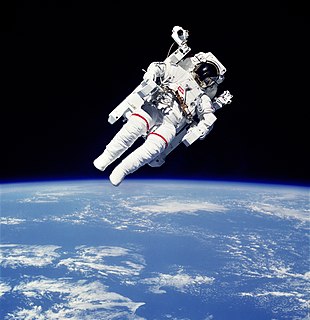
An astronaut is a person trained, equipped, and deployed by a human spaceflight program to serve as a commander or crew member aboard a spacecraft. Although generally reserved for professional space travelers, the term is sometimes applied to anyone who travels into space, including scientists, politicians, journalists, and tourists.

Apollo 10 was a human spaceflight, the fourth crewed mission in the United States Apollo program, and the second to orbit the Moon. NASA described it as a "dress rehearsal" for the first Moon landing, and designated it an "F" mission, intended to test all spacecraft components and procedures short of actual descent and landing. While astronaut John Young remained in the Command and Service Module (CSM) orbiting the Moon, astronauts Thomas Stafford and Gene Cernan flew the Apollo Lunar Module (LM) to within 15.6 kilometers (8.4 nmi) of the lunar surface, the point at which powered descent for landing would begin on a landing mission, before rejoining Young in the CSM. After orbiting the Moon 31 times, Apollo 10 returned safely to Earth; its success enabled the first crewed landing during Apollo 11 two months later.

Apollo 17 was the final mission of NASA's Apollo program, the most recent time humans have set foot on the Moon or traveled beyond low Earth orbit. Commander Gene Cernan and Lunar Module Pilot Harrison Schmitt walked on the Moon, while Command Module Pilot Ronald Evans orbited above. Schmitt was the only professional geologist to land on the Moon, selected in place of Joe Engle with NASA under pressure to send a scientist to the Moon. The mission's heavy emphasis on science meant the inclusion of a number of new experiments, including a biological experiment containing five mice carried in the command module.

Extravehicular activity (EVA) is any activity done by an astronaut outside a spacecraft beyond the Earth's appreciable atmosphere. Normally, the term applies to what has been termed a spacewalk outside a craft that is orbiting Earth. However EVA also applies to lunar surface exploration, as performed by six pairs of American astronauts in the Apollo program from 1969 to 1972. A Stand-up EVA (SEVA) is when an astronaut does not fully leave a spacecraft, but is completely reliant on the space suit for environmental support. Its name derives from the astronaut "standing up" in the open hatch, usually to record or assist a spacewalking astronaut. The Soviet Union/Russia, the United States, Canada, the European Space Agency and China have all conducted EVAs.

Zond 5 was a spacecraft of the Soviet Zond program. In September 1968 it became the first spaceship to travel to and circle the Moon, the first Moon mission to include animals, and the first to return safely to Earth. Zond 5 carried the first terrestrial organisms to the vicinity of the Moon, including two tortoises, fruit fly eggs, and plants. The tortoises underwent biological changes during the flight, but it was concluded that the changes were primarily due to starvation and that they were little affected by space travel.

Konstantin Petrovich Feoktistov was a Soviet cosmonaut and an eminent space engineer. As a cosmonaut Feoktistov flew on Voskhod 1, the first spacecraft to carry three crew members. Feoktistov also wrote several books on space technology and exploration. The Feoktistov crater on the far side of the Moon is named in his honor.

Eugene Andrew Cernan was an American astronaut, naval aviator, electrical engineer, aeronautical engineer, and fighter pilot. During the Apollo 17 mission, Cernan became the eleventh human being to walk on the Moon. As he re-entered the Apollo Lunar Module after Harrison Schmitt on their third and final lunar excursion, he remains as of 2022, famously: "The last man on the Moon".

James Arthur Lovell Jr. is an American retired astronaut, naval aviator, test pilot and mechanical engineer. In 1968, as command module pilot of Apollo 8, he became, with Frank Borman and William Anders, one of the first three astronauts to fly to and orbit the Moon. He then commanded the Apollo 13 lunar mission in 1970 which, after a critical failure en route, circled the Moon and returned safely to Earth.
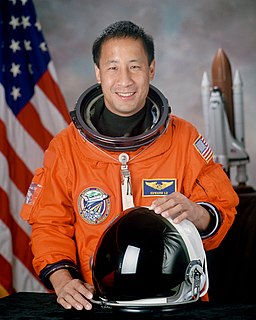
Edward Tsang "Ed" Lu is an American physicist and former NASA astronaut. He flew on two Space Shuttle flights, and made an extended stay aboard the International Space Station.
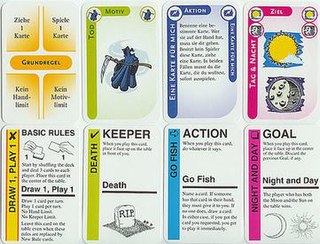
Fluxx is a card game, played with a specially designed deck published by Looney Labs. It is different from most other card games, in that the rules and the conditions for winning are altered throughout the game, via cards played by the players.
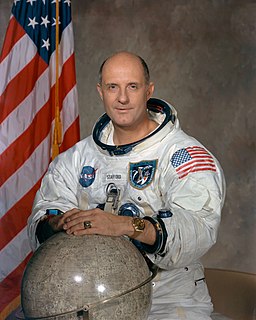
Thomas Patten Stafford is an American former Air Force officer, test pilot, and NASA astronaut, and one of 24 people who flew to the Moon. He also served as Chief of the Astronaut Office from 1969 to 1971.
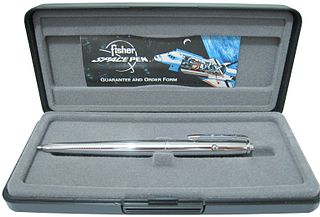
The Space Pen, marketed by Fisher Space Pen Company, is a pen that uses pressurized ink cartridges and is able to write in zero gravity, underwater, over wet and greasy paper, at any angle, and in a very wide range of temperatures.

NASA Astronaut Group 3—'The Fourteen'—was a group of fourteen astronauts selected by NASA for the Gemini and Apollo program. Their selection was announced in October 1963. Seven were from the United States Air Force, four from the United States Navy, one was from the United States Marine Corps and two were civilians. Four died in training accidents before they could fly in space. All of the surviving ten flew Apollo missions; five also flew Gemini missions. Buzz Aldrin, Alan Bean, Gene Cernan and David Scott walked on the Moon.
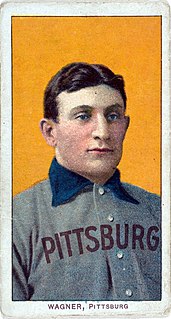
A rookie card is a trading card that is the first to feature an athlete after that athlete has participated in the highest level of competition within their sport. Collectors may value these first appearances more than subsequent card issues. Athletes are often commemorated on trading cards which are highly collected based on the popularity of the athlete. Prices for rookie cards fluctuate based on consumer interest, supply and demand and other factors, but can surpass thousands of dollars.

Music in space is music played in or broadcast from a spacecraft in outer space. The first ever song that was performed in space was a Ukrainian song “Watching the sky...” sang on 12 August 1962 by Pavlo Popovych, cosmonaut from Ukraine at a special request of Serhiy Korolyov, Soviet rocket engineer and spacecraft designer from Ukraine. According to the Smithsonian Institution, the first musical instruments played in outer space were an 8-note Hohner "Little Lady" harmonica and a handful of small bells carried by American astronauts Wally Schirra and Thomas P. Stafford aboard Gemini 6A. Upon achieving a space rendezvous in Earth orbit with their sister ship Gemini 7 in December 1965, Schirra and Stafford played a rendition of "Jingle Bells" over the radio after jokingly claiming to have seen an unidentified flying object piloted by Santa Claus. The instruments had been smuggled on-board without NASA's knowledge, leading Mission Control director Elliot See to exclaim "You're too much" to Schirra after the song. The harmonica was donated to the Smithsonian by Schirra in 1967, with his note that it "...plays quite well".

For All Mankind is an American science fiction drama television series created and written by Ronald D. Moore, Matt Wolpert and Ben Nedivi and produced for Apple TV+. The series dramatizes an alternate history depicting "what would have happened if the global space race had never ended" after the Soviet Union succeeds in the first crewed Moon landing ahead of the United States. The series stars an ensemble cast including Joel Kinnaman, Michael Dorman, Sarah Jones, Shantel VanSanten, Jodi Balfour, and Wrenn Schmidt. Sonya Walger, Krys Marshall, Cynthy Wu, Casey W. Johnson and Coral Peña joined the main cast for the second season, while Edi Gathegi joined in the third. The series features historical figures including Apollo 11 astronauts Neil Armstrong, Buzz Aldrin, and Michael Collins, Mercury Seven astronaut Deke Slayton, rocket scientist Wernher von Braun, NASA Administrator Thomas Paine, NASA flight director Gene Kranz, U.S. senator Ted Kennedy, and U.S. presidents Richard Nixon, Ronald Reagan and Bill Clinton.
References
- 1 2 "Astronauts refusing to sign SpaceShots cards". CollectSpace . Retrieved 16 September 2015.[ unreliable source? ]
- 1 2 3 4 Minor, Debra. "Demand For Space Cards Soars". Orlando Sentinel. Retrieved 15 September 2015.
- ↑ Thomas, Scott. "Non-Fiction in the Cards". Non-Sports Update. Retrieved 16 September 2015.
- ↑ Thomas, Scott. "Spaceflight retrospectives". Trading Card Hobbyist. Retrieved 16 September 2015.
- ↑ Moore, Arden. "Trading Space Astronaut's Son Creates Collection Of Cards Telling Of Orbits And Liftoffs". Sun-Sentinel. Retrieved 16 September 2015.
- 1 2 3 "SpaceShots trading cards signed promo sheets". collectSpace. Retrieved 16 September 2015.[ unreliable source? ]
- ↑ "For the record". Chicago Tribune. Retrieved 16 September 2015.
- ↑ ""Space Shots" ad". Boys Life: 7. August 1991. Retrieved 16 September 2015.
- 1 2 Maschi, Bob (June 1993). "Cardboard Spacecraft". Starlog (191): 35–40.
- ↑ Clary, Mike. "As the Space Mirror turns, focus is on funds : Amid structural problems at the Astronauts Memorial, a probe of its financing is launched". Los Angeles Times. Retrieved 16 September 2015.
- ↑ "Auditors tracking Challenger tag funds". Ocala Star-Banner. Retrieved 16 September 2015.
- ↑ "James Lovell Signing – August 2014" (PDF). NovaSpace. Retrieved 16 September 2015.
- ↑ "Gene Cernan Signing – June 2015" (PDF). NovaSpace. Retrieved 16 September 2015.